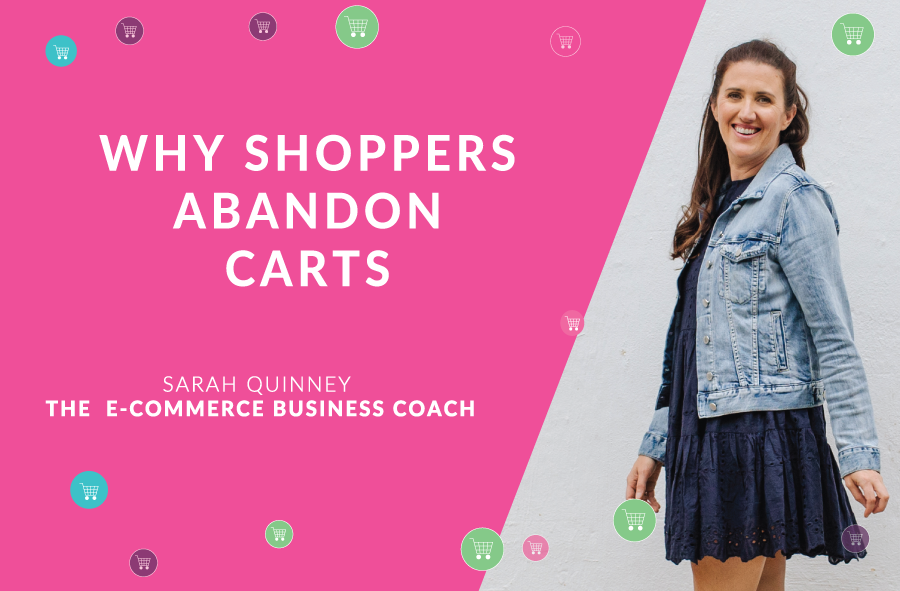
Why Do Shoppers Abandoned Carts?
Here’s a statistic which might shock you: as of Q2 2017, the average abandoned cart across all industries is 76.9%.
Why is it that more than three quarters of ‘add to carts’ are abandoned?
There are a range of reasons which could lead to a shopper abandoning their cart.
- Maybe they were distracted by their crying child in the background.
- Perhaps they didn’t have time to go through your checkout process and create an account on your website.
- They might have decided that the price was too high with shipping fees included.
- An abandoned cart does not mean that you’ve lost the sale.
There are steps that you can take to capitalize on abandoned carts and turn those sales you previously thought you had lost into conversions.
First Things First, Check Your Checkout Process
It’s the final hurdle before you land the sale, but how large is that hurdle?
Put yourself in the shoes of your customer, and ask yourself: “would I like to go through this checkout process?”
If you’re trying to reduce the rate of abandoned carts you receive, I recommend that you try to make the checkout process as simple as possible for your shoppers. I know that it’s tempting to ask your customers to set up an account on your website before they can make a purchase, but this might be why they’re leaving before they seal the deal.
A streamlined, one-page checkout process is advised, and you’ll still get all the information that you need to gain an understanding of your customers (who they are, what they like, when they shop, etc.)
Payment Methods
When you’re running an online store, people from all over the world can purchase products from you, which is something that should be accounted for with the payment methods which you accept.
To ensure that your payment processes are familiar and accessible to your customers, we recommend using a variety of popular gateways, like Paypal or Stripe.
Using popular payment gateways which are used worldwide will help your customers to trust in your store, as they’re already familiar with these tools. The tools themselves also offer protection to both parties, which further works to ease your shoppers into making a purchase.
Remember: the easier it is for your customers to buy a product, the easier it is for you to generate sales.
Be Clear With Shipping Prices and Times
As you may have already noticed from the Statista chart which was used earlier in this article, shipping is a big deal for online shoppers.
In fact, half of the most popular reasons for online shoppers abandoning their cart are related to shipping: ‘expensive shipping’, ‘no free shipping’, ‘unaware of shipping costs’, and ‘slow shipping’.
I can personally attest to shipping prices and times playing a big role in my own purchasing decisions. I can’t remember the amount of times that I’ve decided not to purchase something because I was surprised with expensive shipping fees at the checkout.
Thankfully, there are steps that you can take to avoid your potential customers failing to convert because of issues with your shipping policies.
Be open and honest about your shipping times.
Make sure that your shipping policies are clearly visible and accessible to your shoppers.
This is especially important when you’re running a business.
Entrepreneurs who are using the drop shipping business model are aware that their products will take a little longer to arrive, however, that doesn’t mean that their customers are.
If you set unrealistic expectations for the time it’ll take for your products to be delivered, you’re likely to receive customer complaints. This is detrimental to your brand’s image and can even lead to customers asking for a refund.
Nail Your Product Images
Online shopping is a highly visual experience, and the brain processes images 60x faster than it processes words, so it’s essential that your product images are high-quality.
We know that it’s easy to dismiss your product images to an afterthought whilst you’re running your business.
But, shoppers who visit your store are looking to gain as much information about your products as they can get.
They’re looking to find an e-commerce store which has a variety of pictures on their product listings that show the product from every angle. They need to be sure that they like the product before they purchase it.
There are two ways that you can gain high-quality product photos for your e-commerce store:
- You can reach out to a supplier directly and ask them if they can take some unique product photography for your store.
- You can take the time to order some products which you’re selling to your home. Once they’ve arrived, you can take some great photos yourself, even if you’re not a professional photographer.
It’s important that you have high-quality images on your site. If you want to establish your store as a trustworthy brand, pixelated images are a no-go. Try to provide your audience with the highest quality images that you can – it’ll help you to convert customers.
Utilizing Social Proof to Increase Conversions
It’s easier than ever for a budding entrepreneur to launch their own online store with platforms like Shopify.
With this in mind, shoppers are opting for reputable brands. They don’t want to deal with poor customer service – they only want the best.
As an e-commerce brand, it’s your job to convince them that your store is the best.
How can you do this?
With social proof.
Try adding the ability to leave reviews for your products.
First, add the ability for your customers to leave reviews for the products that they purchase. This is a simple process and can be done through your Shopify store.
Once your customers have made a purchase from your store, ask them to leave a review. It’ll help to build the social proof of your brand, which assures future customers that it’s the right decision to purchase said product.
If shoppers on your store see what past customers have left positive feedback, there’s a much lower chance that they’ll abandon their cart.
Converting Customers With Exit Offers
Exit offers provide store owners with one final chance to convert a customer before they leave their domain.
But how does an exit offer work?
An exit popup will appear when it looks like a user is going to leave the website. The popup will likely offer the shopper something valuable, like a discount code, to try and coax them into making a purchase.
Luckily, it’s relatively easy to setup on your Shopify store. There are many apps that you can use.
You can install apps from Shopify’s App Store like Wheelio, used in the example above, that’ll integrate an exit popup directly into your e-commerce store.
This is especially useful if you’re trying to decrease the number of customers who abandon their carts. Somebody will undoubtedly be a lot less inclined to leave your domain when they’re surprised with a unique discount code.
Ultimately, exit pop-ups can help you to retain the attention of your shoppers, and increase your conversion rate.






